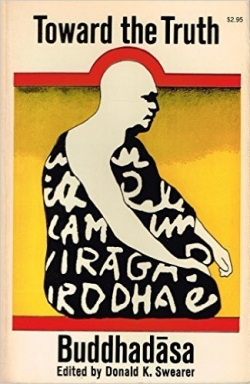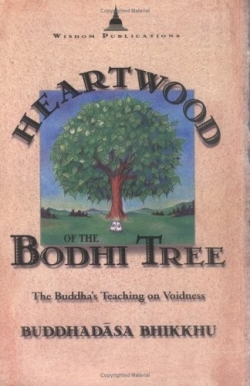Key to Natural Truth

Book Stores
Type
Book
Authors
Buddhadasa ( Buddhadasa Bhikkhu )
Category
Theravada
[ Browse Items ]
Publication Year
1988
Publisher
Dhamma Study and Practice Group, Thailand
Pages
158
Description
From the introduction:
There are five articles or "keys" here. The first, "Kalama Sutta, Help Us!" sets out a fundamental attitude of Buddhism: we should believe something only after examining it, thinking it through carefully, trying it out, and finding for ourselves that it is correct. The Buddhist path of wisdom is meaningless for those who ignore this principle; they turn it into something else. This key comes from a series of pamphlets recently written by Ajahn Buddhadasa and called "Saccasara From Suan Mokkh." (sacca means "truth" and sara means both "essence" and "message"). The translation here was begun by Dr. Supaphan Na Bangchang and finished by the editor.
"Two Kinds of Language," the second key, was translated in 1970 by Roderick Bucknell (at that time Ariyananda Bhikkhu) and has been long out of print. The third key, "Looking Within," was translated in 1978 by the same translator, and is now published for the first time. Both of these keys help us to apply the principle of the Kalama Sutta. "Two Kinds of Language" shows how to discriminate between the two levels of language which are intertwined in all spiritual speech and literature. Both levels of language must be acknowledged and understood if we are to benefit from the Buddha's teaching, and Ajahn Buddhadasa gives many examples of how to do so.
The third key shows us where to verify the truths taught by others. Here the Venerable Ajahn counteracts our tendency to be engrossed by external things and orients us in the direction of spiritual truth. He emphasizes that we must look beyond relative and superficial truth to find real truth. The key to doing this is "looking within." To help us begin this necessary introspection, he shows us the difference between observing external material phenomena and observing internal mental phenomena. Through the latter, the Dhamma may be realized directly and independently.
"Happiness & Hunger," the fourth key, was translated by the editor and originally appeared in 1987 in "Evolution/ Liberation, " a small journal produced, occassionally, at Suan Mokkh. The aim of this article is to clarify the proper motivation for Dhamma study and practice. We tend to ask of Dhamma what it is not meant to provide. Sometimes we even play at Dhamma. Those who seek happiness would do best to find out what they really want, and whether or not the Dhamma can provide it.
The last key here, "The Dhamma-Truth of Samatha-Vipassana for the Nuclear Age," is a recent translation by the editor. It discusses a few important issues which are regularly confused. First, the way of life taught by the Buddha is one unified path. If we unnaturally cut it into pieces, it cannot function spiritually. If we try to practice just this aspect or that, we will never realize even that fragment, let alone the whole Dhamma. Second, we create our own problems and suffering; therefore we must solve them ourselves. We should not let our personal truths get in the way of the real truth which frees us. Lastly, we live in an increasingly dangerous world; we have no time to waste. We must be vigilant and practice earnestly.
There are five articles or "keys" here. The first, "Kalama Sutta, Help Us!" sets out a fundamental attitude of Buddhism: we should believe something only after examining it, thinking it through carefully, trying it out, and finding for ourselves that it is correct. The Buddhist path of wisdom is meaningless for those who ignore this principle; they turn it into something else. This key comes from a series of pamphlets recently written by Ajahn Buddhadasa and called "Saccasara From Suan Mokkh." (sacca means "truth" and sara means both "essence" and "message"). The translation here was begun by Dr. Supaphan Na Bangchang and finished by the editor.
"Two Kinds of Language," the second key, was translated in 1970 by Roderick Bucknell (at that time Ariyananda Bhikkhu) and has been long out of print. The third key, "Looking Within," was translated in 1978 by the same translator, and is now published for the first time. Both of these keys help us to apply the principle of the Kalama Sutta. "Two Kinds of Language" shows how to discriminate between the two levels of language which are intertwined in all spiritual speech and literature. Both levels of language must be acknowledged and understood if we are to benefit from the Buddha's teaching, and Ajahn Buddhadasa gives many examples of how to do so.
The third key shows us where to verify the truths taught by others. Here the Venerable Ajahn counteracts our tendency to be engrossed by external things and orients us in the direction of spiritual truth. He emphasizes that we must look beyond relative and superficial truth to find real truth. The key to doing this is "looking within." To help us begin this necessary introspection, he shows us the difference between observing external material phenomena and observing internal mental phenomena. Through the latter, the Dhamma may be realized directly and independently.
"Happiness & Hunger," the fourth key, was translated by the editor and originally appeared in 1987 in "Evolution/ Liberation, " a small journal produced, occassionally, at Suan Mokkh. The aim of this article is to clarify the proper motivation for Dhamma study and practice. We tend to ask of Dhamma what it is not meant to provide. Sometimes we even play at Dhamma. Those who seek happiness would do best to find out what they really want, and whether or not the Dhamma can provide it.
The last key here, "The Dhamma-Truth of Samatha-Vipassana for the Nuclear Age," is a recent translation by the editor. It discusses a few important issues which are regularly confused. First, the way of life taught by the Buddha is one unified path. If we unnaturally cut it into pieces, it cannot function spiritually. If we try to practice just this aspect or that, we will never realize even that fragment, let alone the whole Dhamma. Second, we create our own problems and suffering; therefore we must solve them ourselves. We should not let our personal truths get in the way of the real truth which frees us. Lastly, we live in an increasingly dangerous world; we have no time to waste. We must be vigilant and practice earnestly.
Number of Copies
3
| Library | Accession No | Call No | Copy No | Edition | Location | Availability |
|---|---|---|---|---|---|---|
| Main | 242 | 1 | Yes | |||
| Main | 247 | 2 | Yes | |||
| Main | 273 | 3 | Yes |



